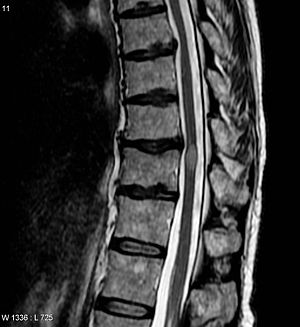User:Mr. Ibrahem/Transverse myelitis
| Transverse myelitis | |
|---|---|
 | |
| A MRI showing an area of transverse myelitis, which is lighter, oval shape at center-right. The person recovered after 3 months. | |
| Medical specialty | Neurology |
| Symptoms | Weakness or numbness of the limbs, bowel or bladder problems, lower back pain, muscle spasms[1] |
| Complications | Breathing problems[1] |
| Usual onset | Over hours to weeks[1] |
| Causes | Uncertain, post infectious, immune system disorders[1] |
| Diagnostic method | Based on symptoms, supported by MRI and lumbar puncture[1] |
| Differential diagnosis | Multiple sclerosis, lupus, vitamin B12 deficiency[1][2] |
| Treatment | Corticosteroids, plasmapheresis, intravenous immunoglobulin (IVIG), cyclophosphamide[1] |
| Prognosis | Good (33%), moderate (33%), poor (33%)[1][3] |
| Frequency | 4 per million per year[3] |
Transverse myelitis (TM) is an inflammation of the spinal cord.[1] Symptoms depend on the level of the cord affected.[1] Symptoms may include weakness or numbness of the limbs, bowel or bladder problems, lower back pain, and muscle spasms.[1] Onset can be over hours to weeks.[1] Complications may include breathing problems.[1]
The cause is unknown in 60% of cases.[1] Other cases occurring following various infections, immune system disorders, or other inflammatory disorders.[1] In certain cases the underlying mechanism is believed to involve autoantibodies.[1] Diagnosis is based on symptoms and supported by MRI and lumbar puncture.[1] Other conditions that may present similarly include multiple sclerosis, lupus, and vitamin B12 deficiency.[1][2]
Treatment may include corticosteroids, plasmapheresis, intravenous immunoglobulin (IVIG), and cyclophosphamide.[1] Pain medication such as ibuprofen or naproxen may be used.[1] After a period of bed rest, physical therapy may be useful.[1] While some recover completely others are left with permanent disabilities.[1] Recovery can take up to three years.[1]
Transverse myelitis is rare, occurring in about 4 per million people a year.[3] Males and females are affected equally frequently.[3] Those between the ages of 10 and 20 and 30 to 40 are most commonly affected.[3] The condition was first described in 1882 by the English neurologist Henry Bastian.[4][2]
References
change- ↑ 1.00 1.01 1.02 1.03 1.04 1.05 1.06 1.07 1.08 1.09 1.10 1.11 1.12 1.13 1.14 1.15 1.16 1.17 1.18 1.19 1.20 1.21 1.22 "Transverse myelitis". Genetic and Rare Diseases Information Center (GARD) – an NCATS Program. Archived from the original on 4 January 2018. Retrieved 3 January 2018.
{{cite web}}: More than one of|archivedate=and|archive-date=specified (help); More than one of|archiveurl=and|archive-url=specified (help) - ↑ 2.0 2.1 2.2 "Transverse Myelitis". NORD (National Organization for Rare Disorders). Archived from the original on 29 November 2020. Retrieved 21 November 2020.
{{cite web}}: More than one of|archivedate=and|archive-date=specified (help); More than one of|archiveurl=and|archive-url=specified (help) - ↑ 3.0 3.1 3.2 3.3 3.4 Simone, CG; Emmady, PD (January 2020). "Transverse Myelitis". StatPearls. PMID 32644728.
- ↑ Dale RC, Vincent A (19 January 2010). Inflammatory and Autoimmune Disorders of the Nervous System in Children. John Wiley & Sons. pp. 96–106. ISBN 978-1-898683-66-7. Archived from the original on 4 May 2021. Retrieved 20 October 2016.
{{cite book}}: More than one of|accessdate=and|access-date=specified (help); More than one of|archivedate=and|archive-date=specified (help); More than one of|archiveurl=and|archive-url=specified (help)